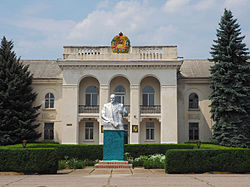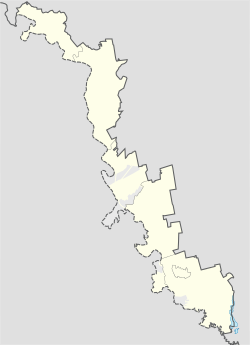Dubăsari
Dubăsari Dubossary | |
|---|---|
 Liberal Arts College | |
| Coordinates: 47°16′N 29°10′E / 47.267°N 29.167°E | |
| Country (de jure) | |
| Country (de facto) | |
| Population (2004) | |
• Total | 28,500 |
| Time zone | UTC+2 (EET) |
| • Summer (DST) | UTC+3 (EEST) |
| Climate | Dfa |
| Website | http://www.dubossary.ru/ |
Dubăsari (Romanian pronunciation: [dubəˈsarʲ]; Moldovan Cyrillic: Дубэсарь) or Dubossary (Russian: Дубоссары; Yiddish: דובאסאר; Ukrainian: Дубоcсари) is a city in Transnistria, with a population of 23,650. Claimed by both the Republic of Moldova and the Transnistrian Moldavian Republic, the city is under the latter's administration, and functions as the seat of the Dubăsari District.
Name
The origin of the town name is the plural form of the Romanian archaic word dubăsar ("boatman"), a derivative of dubă ("a small wooden boat"), so "Dubăsari" means "boatmen".
History
Dubăsari is the site of one of the oldest settlements in Moldova, and the Transnistrian region. Stone Age artifacts have been found in the area, and there are several kurgans (presumed Scythian) around the city. First mentions of modern Dubăsari date to the beginning of the 16th century, as a fair populated by Moldavian peasants. The settlement became part of the Russian Empire in 1792 and was granted city status in 1795. It was part of Kherson Governorate from 1803 to 1922.
The murder of a Ukrainian boy, Mikhail Rybachenko, in Dubăsari became one of the triggers of the Kishinev pogrom after the Bessarabetz paper insinuated that he had been murdered by the Jewish community for the purpose of using their blood in the preparation of matzo for Passover.[1] Unlike in Kishinev, the authorities at Dubăsari acted to prevent the pogrom in the town.[2][3]
In 1924–1940, Dubăsari was part of the Soviet-created Moldavian ASSR. The town was heavily industrialized during the pre-WWII period. In the course of World War II, in 1940, when Bessarabia was occupied by the Soviet Union, it became part of the newly created Moldavian SSR. On 27 July 1941, the town was occupied by German and Romanian troops. It was re-captured by Soviet forces in the summer of 1944.
In 1951–1954, the Dubăsari dam and a 48 MW hydroelectric power plant Dubossarskaya GES was constructed, and the Dubossary Reservoir was formed.
Dubăsari and its suburbs were the sites of major conflict during 1990–1992 that eventually culminated in the War of Transnistria (1992). Since then, it has been controlled by the breakaway administration of Transnistria, and tensions have risen most recently during the 2022 Russian invasion of Ukraine.
The city's economy was significantly damaged during the war in 1992.
Climate
| Climate data for Dubăsari (1991-2020) | |||||||||||||
|---|---|---|---|---|---|---|---|---|---|---|---|---|---|
| Month | Jan | Feb | Mar | Apr | May | Jun | Jul | Aug | Sep | Oct | Nov | Dec | Year |
| Mean daily maximum °C (°F) | 1.3 (34.3) |
3.8 (38.8) |
9.9 (49.8) |
17.5 (63.5) |
23.5 (74.3) |
27.5 (81.5) |
29.8 (85.6) |
29.4 (84.9) |
23.5 (74.3) |
16.3 (61.3) |
8.7 (47.7) |
3.2 (37.8) |
16.2 (61.1) |
| Daily mean °C (°F) | −1.7 (28.9) |
−0.1 (31.8) |
4.7 (40.5) |
11.3 (52.3) |
17.1 (62.8) |
21.2 (70.2) |
23.3 (73.9) |
22.7 (72.9) |
17.2 (63.0) |
10.8 (51.4) |
5.1 (41.2) |
0.2 (32.4) |
11.0 (51.8) |
| Mean daily minimum °C (°F) | −4.4 (24.1) |
−3.2 (26.2) |
0.5 (32.9) |
5.8 (42.4) |
11.3 (52.3) |
15.5 (59.9) |
17.5 (63.5) |
16.7 (62.1) |
11.9 (53.4) |
6.5 (43.7) |
2.2 (36.0) |
−2.3 (27.9) |
6.5 (43.7) |
| Average precipitation mm (inches) | 36 (1.4) |
28 (1.1) |
30 (1.2) |
37 (1.5) |
55 (2.2) |
60 (2.4) |
67 (2.6) |
46 (1.8) |
49 (1.9) |
40 (1.6) |
43 (1.7) |
48 (1.9) |
539 (21.3) |
| Average precipitation days (≥ 1.0 mm) | 7 | 5 | 6 | 6 | 8 | 8 | 7 | 5 | 5 | 5 | 6 | 6 | 74 |
| Source: NOAA NCEI[4] | |||||||||||||
Population

In 1989, the population of the city was 35,806, including 15,414 Moldovans (Romanians) (43.05%), 10,718 Ukrainians (29.93%), 8,087 Russians (22.59%), and 1,587 others (4.43%). According to the 2004 Census in Transnistria, the city had 23,650 inhabitants,[5] including 8,954 Moldovans (37.86%), 8,062 Ukrainians (34.09%), 5,891 Russians (24.91%), 153 Belarusians, 104 Bulgarians, 90 Armenians, 49 Poles, 66 Gagauzians, 46 Jews, 39 Germans, 31 Gypsies, and 165 others and non-declared.[6]
Notable natives
- Victor Covalenco (born 1975), Moldovan decathlete
- Louis Filler (1911–1998), American teacher and scholar
- Igor Gorgan (born 1969), Moldovan military officer
- Vlad Grecu (born 1959), Moldovan writer
- Yulia Lisnik (born 1966), retired Moldovan race walker
- Anna Odobescu (born 1991), Moldovan singer and actress
- Mykhaylo Okhendovsky (born 1973), Ukrainian lawyer
- Igor Pugaci (born 1975), retired Moldovan road bicycle racer
- Pyotr Rachkovsky (1853–1910), chief of the Okhrana, the secret police in the Russian Empire
- Nikolay Sklifosovsky (1836–1904), Russian surgeon and physiologist
In fiction
- The Sisters of the Winter Wood by Rena Rossner is set in Dubăsari, before and during the 1903 Kishinev pogrom.[7][8]
Notes
- ^ Transnistria's political status is disputed. It considers itself to be an independent state, but this is not recognised by any UN member state. The Moldovan government and the international community consider Transnistria a part of Moldova's territory.
References
- ^ Davitt, Michael (1903). Within The Pale. London: Hurst and Blackett. pp. 98–100.
- ^
 Rosenthal, Herman; Rosenthal, Max (1901–1906). "Kishinef (Kishinev)". In Singer, Isidore; et al. (eds.). The Jewish Encyclopedia. New York: Funk & Wagnalls.
Rosenthal, Herman; Rosenthal, Max (1901–1906). "Kishinef (Kishinev)". In Singer, Isidore; et al. (eds.). The Jewish Encyclopedia. New York: Funk & Wagnalls.
- ^ Klier, John Doyle; Lambroza, Shlomo (1992). Pogroms: Anti-Jewish Violence in Modern Russian History. Cambridge University Press. p. 202. ISBN 978-0-521-52851-1.
- ^ "World Meteorological Organization Climate Normals for 1991-2020: Dubasari" (CSV). ncei.noaa.gov. NOAA. Retrieved 4 February 2024.
- ^ "pridnestrovie.net". Archived from the original on 2010-07-26. Retrieved 2009-07-20.
- ^ The Transnistrian census of 2004 data by nationality at http://pop-stat.mashke.org/pmr-ethnic-loc2004.htm
- ^ Rena, Rossner (2018-09-25). The sisters of the winter wood (First ed.). New York, NY. ISBN 978-0316483254. OCLC 1009182096.
{{cite book}}: CS1 maint: location missing publisher (link) - ^ "The Sisters of the Winter Wood by Rena Rossner | Jewish Book Council". www.jewishbookcouncil.org (in Brazilian Portuguese). Retrieved 2018-10-28.
External links
- (in Polish) Dubosary (Dubăsari) in the Geographical Dictionary of the Kingdom of Poland (1881)
- Site of city of Dubăsari
- Dubăsari (in Romanian)




